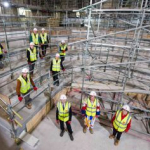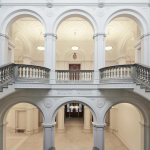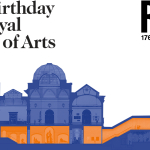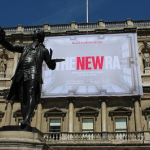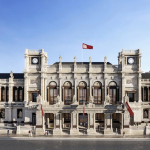The Royal Academy of Arts, the world’s foremost artist and architect-led institution, will open its new campus to the public on Saturday 19 May 2018 as part of the celebrations of its 250th anniversary year.
Following a transformational redevelopment, designed by internationally-acclaimed architect Sir David Chipperfield CBE RA and supported by the National Lottery, the new Royal Academy will open up and reveal more of the elements that make the RA unique – sharing with the public historic treasures from its Collection, the work of its Royal Academicians and the Royal Academy Schools, and its role as a centre for debate about art and architecture – alongside its world-class exhibitions programme.
One of the key features of the redevelopment is the new Weston Bridge between Burlington House and Burlington Gardens, uniting the two-acre campus and creating a new route between Piccadilly and Mayfair. The unified campus provides 70% more public space than the RA’s original Burlington House footprint, enabling the RA to expand its exhibition and events programme, and to create new and free displays of art and architecture across the campus for visitors year-round. From dedicated galleries and displays exploring its foundation and history in training artists, to changing exhibits and interventions devoted to showcasing contemporary works by Royal Academicians and students at the art school at the heart of the campus. The display of the Royal Academy Collection has been curated by Royal Academicians and designed by renowned museographer Adrien Gardère.
The Gabrielle Jungels-Winkler Galleries provides the Royal Academy with an impressive third suite of galleries for temporary exhibitions. Refurbished with state of the art conditions, the galleries are naturally day-lit and will support an exhibition programme of contemporary art and architecture. They will be inaugurated by Tacita Dean’s exhibition LANDSCAPE (19 May – 12 August 2018).
Since 1768, the Royal Academy’s founding principle has been to promote the creation, enjoyment and appreciation of the visual arts and architecture, which the RA has achieved through a rich public programme of discussion and debate as well as exhibitions. The creation of the new 250-seat Benjamin West Lecture Theatre, the Clore Learning Centre and the restoration of the Wolfson British Academy Room, will give the RA permanent spaces for it to thrive as a hub of learning and debate well into the future. Animating the campus throughout the year, the RA’s new public events programme will increase in scale and ambition, featuring festivals, major talks and in-conversations, architecture awards, more hands-on creative educational activities for families, schools and community groups, as well as academic courses and classes for adult learners and the newly launched Executive Master in Cultural Leadership, reaching out to new and diverse audiences of all ages in the practice and study of art and architecture.
A new public route through the campus will integrate the Royal Academy Schools, located at the very heart of the Academy, into the visitors’ experience revealing the Academy’s important role in arts education and its long tradition of training artists. The new Weston Studio, a public project space for students and alumni, and views of the Schools’ Corridor and the newly landscaped Lovelace Courtyard, will provide visitors with a greater insight into Britain’s longest established art school.
New spaces to eat, drink and relax include the Senate Room bar and all-day restaurant located within The Dorfman Senate Rooms on the first floor. The room is a magnificent double-height space, formerly the meeting place of the Senate of the University of London. It has been fully restored to the highest conservation standards by David Chipperfield Architects. Further cafes and shops will be located either side of the Burlington Gardens entrance. Other extensive improvements have been made across the campus to create new ticket desks, bathrooms and cloakrooms.
The transformation of the Royal Academy has included the vital conservation of the Grade II* listed building of 6 Burlington Gardens. Designed by Sir James Pennethorne (1801 – 1871) as the headquarters for the University of London on a site which had previously been part of the garden of Burlington House, it was regarded as a masterpiece of mid-Victorian architecture. Acquired by the Royal Academy in 2001, its former tenants included the Civil Service Commission, the British Academy and the British Museum’s Museum of Mankind. The new David Chipperfield designed architecture, together with the careful conservation of the façade, the reinstatement of the lecture theatre and restoration of The Dorfman Senate Rooms by Julian Harrap Architects, will contribute to the nationally renowned significance of Burlington Gardens.
In its 250th year, the new Royal Academy of Arts will become a major cultural destination in central London, with year-round access to a significantly expanded public programme and with more space to make, debate and exhibit art and architecture than ever before.
Opening Weekend of the new Royal Academy of Arts
To celebrate the opening of the new Royal Academy, a weekend-long art party on the 19 and 20 May will present free workshops, tours, displays, late-night performances and DJs. Highlights include performances by The Uncollective and Rachael Plays Disco; Collaborative
Mural Drawing, Party Hat Making and Architectural Model Making; Rainbow participatory performance in the front hall of Burlington Gardens with Musarc; RA Collection Gallery Tours; and a Family printmaking workshop in the new Clore Learning Centre. All against a backdrop of street food and cocktail bars in the RA’s Annenberg Courtyard.
New Exhibition Spaces and Free Displays
Tacita Dean’s exhibition LANDSCAPE (19 May – 12 August 2018) will inaugurate the new Gabrielle Jungels-Winkler Galleries in Burlington Gardens. With lead support from Art Fund, the exhibition is part of an unprecedented collaboration with the National Portrait Gallery and the National Gallery in London. It will showcase the internationally-renowned visual artist and Royal Academician Tacita Dean who will explore the genre of landscape in its broadest sense.
The magnificent new Royal Academy Collection Gallery will present The Making of an Artist: The Great Tradition highlighting works from the RA Collection, including the ‘Taddei Tondo’ by Michelangelo and the RA’s almost full-size sixteenth century copy of Leonardo da Vinci’s The Last Supper, along with paintings by Reynolds, Kauffman, Thornhill, Constable, Gainsborough and Turner. Selected by the President of the Royal Academy, Christopher Le Brun, it will focus on the first sixty years of the RA, juxtaposing masterpieces from the RA’s teaching collection with Diploma Works by past Royal Academicians. The display of the RA Collection has been supported by the Blavatnik Family Foundation.
The Architecture Studio within The Dorfman Senate Rooms will provide a creative space that invites audience engagement with innovative and critical ideas on architecture and its intersection with the arts. It will open with Invisible Landscapes (19 May 2018 – 4 March 2019), explored in three ‘Acts’ of immersive interventions looking at the impact of digital technology on society. In contrast, recently conserved architectural casts on display in The Dorfman Architecture Court will convey the tradition of learning to draw from casts of buildings as used historically by students in the RA Schools.
Located at the entrance to the Weston Bridge, which connects Burlington Gardens to Burlington House, The Ronald and Rita McAulay Gallery will stage site-specific installations by Royal Academicians. The first major work will be Tips for a Good Life by Bob and Roberta Smith RA (September 2018 – September 2019), on the subject of gender in the history of the RA.
Moving through to Burlington House, visitors will arrive at the Weston Studio. A changing contemporary series will bring the ethos and thinking of the RA Schools’ postgraduate programme to life with two displays a year and projects developed by students and graduates. It will open with Honeymoon, a group exhibition of works by first year students, revealing their rich use of subjects, approaches, methods and materials.
Going back in time, The Vaults will exhibit The Making of an Artist: Learning to Draw a formidable selection of plaster casts from the early years of the RA Schools displayed together with works on paper from the RA’s teaching collection, illustrating the RA’s role in the teaching of art since the RA Schools’ foundation in 1769. Works will include anatomical casts and casts of antique sculptures, such as the Venus de Milo and Farnese Hercules, juxtaposed with recent works on related themes by RA Schools graduates. Works on paper include a special display From The Child To The President about John Everett Millais PRA, who aged 11 started in the RA Schools where he was known as ‘The Child’. The restoration of the Vaults into a public route between the two buildings was supported by The Monument Trust.
Further interventions in Burlington House will include an installation of three-dimensional details from buildings designed by current architect Academicians. Curated by Spencer de Grey RA and displayed across a three-story vertical wall, it will celebrate the work of distinguished British architects (opens 5 June).
New places to eat, shop and relax
The ground floor features a series of spaces designed to welcome visitors throughout the day: places to meet, eat, drink and shop. The Newsstand will be open from 8am (10am on a Sunday) with art magazines, cards, stationery and stamps and news of what’s happening across the RA throughout the day. Also open from 8am is the Poster Bar, designed as a stop-off for visitors wanting a quick reviving coffee or drink, to eat in or takeaway. The space also works as an ideal meeting place, visible from the Ticket Desk. Open until 7pm it is designed to support the Lecture Theatre programme and to work as a space for book signings and other activities in future. The RA’s history is evident in a wall of 50 newly reproduced posters, all for sale in a range of sizes, and links to the books and prints for sale in the adjacent Shop, which is designed to flex according to demand and the time of year. During exhibitions, the shop offer will be focused around the programme; at quieter times, it will offer Personal Shopping service and provide a peaceful alternative to the bustle of the main shop in Burlington House.
On the first floor, the Senate Room is the main café and bar for Burlington Gardens, with comfortable seating and a full all-day menu. Inspired by its architectural surroundings the menu is Italian in style, and features a bakery and coffee in the morning, small plates and open sandwiches for lunch, through to afternoon tea and then cocktails and supper. The Senate Room will be open from 10am - 10pm, with full opening hours and menu commencing with the Summer Exhibition.
Note to Editors
New Royal Academy of Arts
Dates and Opening Hours
Opening weekend: Saturday 19 May 10am-10pm and Sunday 20 May 2018 10am-6pm
Exhibition opening hours: Open daily 10am – 6pm (last admission 5.30pm) and Fridays until 10pm (last admission 9.30pm)
For further information on new opening hours for Burlington Gardens please visit:
royalacademy.org.uk/plan-your-visit
Transforming the Royal Academy of Arts
The Royal Academy Development Trust, Chaired by Lord Mervyn Davies, has played a significant role in securing funding for the project. The redevelopment has been funded with a £12.7 million grant from the National Lottery. Major support has also been received from a number of private individuals, including Mrs Gabrielle Jungels-Winkler, Ronald and Rita McAulay, The McLennan Family, The Mead Family Foundation, Mr and Mrs Robert Miller and Sir Simon and Lady Robertson, as well as trusts and foundations including the Blavatnik Family Foundation, The Cadogan Charity, Clore Duffield Foundation, the Dorfman Foundation, Dunard Fund, The Foyle Foundation, The Garfield Weston Foundation, The Maurice Wohl Charitable Foundation, The Monument Trust, The Rothschild Foundation and The Wolfson Foundation.
The Royal Academy of Arts launched a public appeal ‘Make Your Mark’ to raise £3 million which helped complete its transformative redevelopment, realise the ambitious plans for its 250th anniversary in 2018 and to ensure the next 250 years of the Academy as Britain’s foremost independent, artist and architect-led institution. For further information visit: https://roy.ac/mym
For more information on the RA250 visit: www.royalacademy.org.uk/ra250#video
About the Heritage Lottery Fund (HLF)
Thanks to National Lottery players, we invest money to help people across the UK explore, enjoy and protect the heritage they care about - from the archaeology under our feet to the historic parks and buildings we love, from precious memories and collections to rare wildlife. www.hlf.org.uk. Follow us on Twitter, Facebook and Instagram and use #HLFsupported and #NationalLottery.
BNY Mellon BNY Mellon is a global investments company dedicated to helping its clients manage and service their financial assets throughout the investment lifecycle. Whether providing financial services for institutions, corporations or individual investors, BNY Mellon delivers informed
investment management and investment services in 35 countries. As of March 31, 2018, BNY Mellon had $33.5 trillion in assets under custody and/or administration, and $1.9 trillion in assets under management. BNY Mellon can act as a single point of contact for clients looking to create, trade, hold, manage, service, distribute or restructure investments. BNY Mellon is the corporate brand of The Bank of New York Mellon Corporation (NYSE: BK). Additional information is available on www.bnymellon.com. Follow us on Twitter @BNYMellon or visit our newsroom at www.bnymellon.com/newsroom for the latest company news.
Social Media
Join the discussion online at:
Facebook /royalacademy
Instagram @royalacademyarts
Twitter @royalacademy
#RA250
#TheNewRA
#TacitaDean
About the Royal Academy of Arts
The Royal Academy of Arts was founded by King George III in 1768. It has a unique position in being an independent, privately funded institution led by eminent artists and architects whose purpose is to be a clear, strong voice for art and artists. Its public programme promotes the creation, enjoyment and appreciation of the visual arts through exhibitions, education and debate.
For further press information, please contact Susie Gault, Head of Communications, on 020 7300 5615 or susie.gault@royalacademy.org.uk
For public information, please print: 020 7300 8090 or www.royalacademy.org.uk
Royal Academy of Arts, Burlington House, Piccadilly, London W1J OBD
14.05.18


